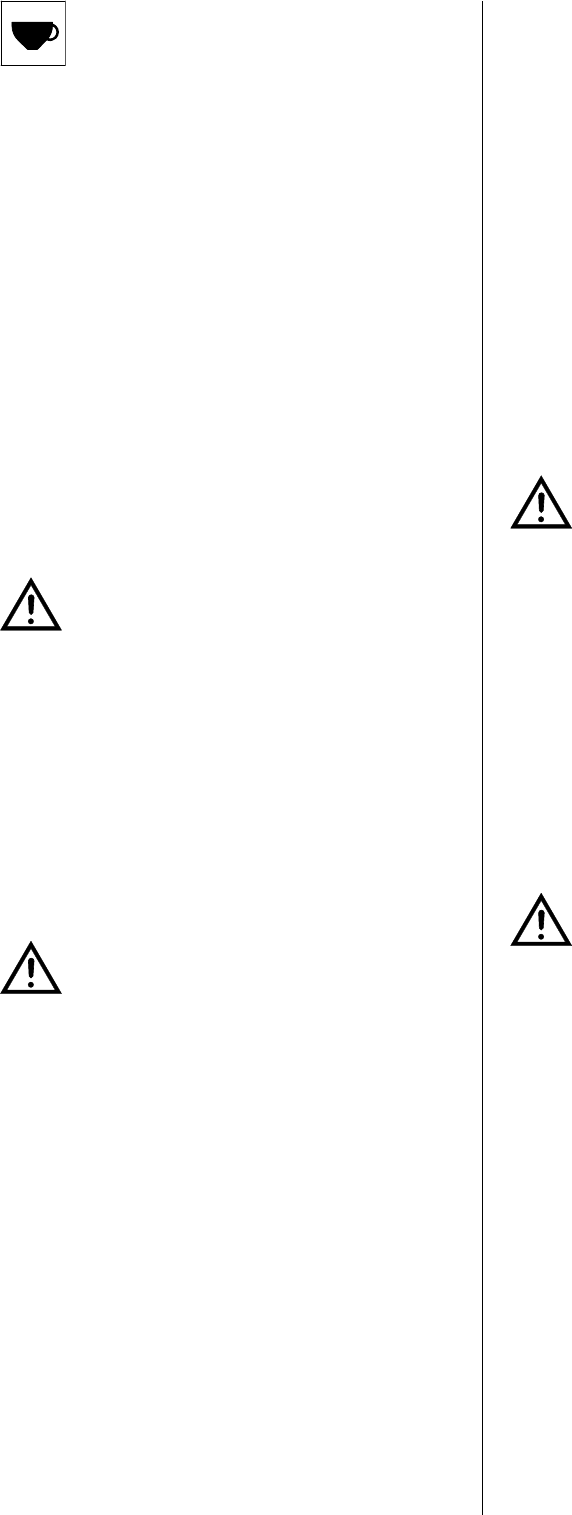
53
8. USE
The machine has a top shelf on which the
cups are kept and heated, ready for use.
This is very important to obtain good coffee as the
pre-warmed cup stops the coffee from growing cold
too quickly.
8.1. Preparing coffee
● Unclamp the filter-holder from the dispensing unit
and knock any grouts out into the drawer espe-
cially provided for this purpose, taking care not to
damage the rim of the filter.
● Use the filter for 1 or 2 coffees, according to
need.
● Fill the filter with the measure of coffee, level it off
and press it down gently with the presser.
● Remove any ground coffee that has stuck to the
rim of the filter while pressing.
If ground coffee is left on the rim of the filter, a
leaktight seal is not ensured, with consequent
leaking of water and coffee grounds.
● Lock the filter-holder into the dispensing unit firmly
to obtain a leaktight seal.
● Place the cups under the spouts and start pouring
using control 3 or button panel 4 according to
model (Fig.6).
● When the coffee has been poured, leave the filter-
holder attached to the dispensing unit until the next
coffee is required.
When pouring, beware of the hot parts of the
machine, especially the coffee dispensing
units, the steam and hot water spouts. Do not
put your hands for any reason under the units
and the spouts when they are operating.
The grinding of the coffee beans is of fundamental
importance to the making of good coffee, and the
granular texture of the resulting grounds should be
such that it takes 25-30 seconds to produce the
beverage. If the coffee is ground too coardsely the
coffee will be pale in colour and weak in flavour, with
only a very small amount of white cream, and if the
grounds are too fine, the coffee will be dark with no
cream. Good coffee can only be made if the beans
are freshly and uniformly ground (only possible when
the blades of the coffee grinder are sharp) and are
then measured out into the correct quantities (roughly
6 grams per measure).
The importance of freshly ground coffee beans is due
to the fact that once ground, they rapidly lose their
aromatic qualities, and fats present in the beans go
rancid.
8.2. Preparing cappuccino (Fig.8)
● Make cup of cappuccino with the express coffee.
● Use a high and narrow jug, half-filled with milk.
● Place the jug under the spout so that the nozzle
touches the bottom.
● Turn on the steam tap (6 - Fig.6) and lower the jug
so that the nozzle is almost at the surface of the
milk.
● Continuously move the jug up and down so that
the nozzle moves in and out of the milk, causing
it to froth.
● Turn off the steam tap and pour the milk into the
cup.
Immediately after carrying out this operation,
clean the spout with a sponge or a clean
cloth so that the milk does not dry on it. Be
careful as the spout is hot and may burn
your hand.
8.3. Heating a beverage
● Immerse the steam spout into the liquid to be
heated.
● Gradually turn on the steam tap 6 (Fig.6); the
steam that bursts in the liquid heats it to the desired
temperature.
● Turn off the steam tap when the desired tempera-
ture has been reached.
Immediately after carrying out this operation,
clean the spout with a sponge or clean cloth.
Be careful as the spout is hot and may burn
your hand.
8.4. Preparing tea, camomile, etc.
● Place the jug under the hot water spout and turn
the water tap 5. When the desired quantity has
been obtained, turn off the tap.
● Add the beverage desired.
When purified water is used, these beverages often
assume a darker colour.
Should the user prefer a lighter coloured drink, draw
fresh water from an ordinary tap and proceed with
the heating phase as described in point 8.3.


















